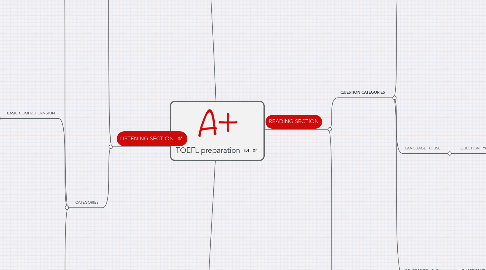
1. LISTENING SECTION
1.1. STRATEGIES
1.1.1. TAKE NOTES ON MAJOR POINTS
1.1.1.1. MAIN IDEA
1.1.1.2. PURPOSE
1.1.1.3. ATTITUDE
1.1.1.4. SUPPORTING POINTS
1.1.1.5. RECORD NOTES IN SORT PHRASES
1.1.2. PRACTICE ACTIVE LISTENING
1.1.2.1. ASK YOURSELF QUESTIONS
1.1.2.2. PREDICT
1.2. SECTIONS
1.2.1. 2 CONVERSATIONS BETWEEN 2 PEOPLE
1.2.2. 2 LECTURES WITH STUDENTS COMMENTS AND QUESTIONS
1.2.3. 2 LECTURES
1.3. CATEGORIES
1.3.1. UNDERSTANDING LANGUAGE USE
1.3.1.1. questions
1.3.1.1.1. Understanding the Function of What Is Said
1.3.1.1.2. Understanding the Speaker’s Attitude
1.3.2. BASIC COMPREHENNSION
1.3.2.1. QUESTIONS
1.3.2.1.1. Gist-Content
1.3.2.1.2. Gist-Purpose
1.3.2.1.3. detail
1.3.3. THE ABILITY TO LEARN
1.3.3.1. questions
1.3.3.1.1. Understanding Organization
1.3.3.1.2. Connecting Content
1.3.3.1.3. Making Inferences
2. made by: 11b Maralgoo
3. citation
3.1. https://www.bestmytest.com/blog/toefl-reading-question-types
3.2. http://www.toeflgoanywhere.org/5-tips-tackling-listening-section
3.3. book
4. READING SECTION
4.1. QUESTION CATEGORIES
4.1.1. BASIC COMPREHENSION
4.1.1.1. QUESTION TYPES
4.1.1.1.1. FACTS/DETAILS
4.1.1.1.2. PARAPHRASING
4.1.1.1.3. NOT/EXCEPT
4.1.1.1.4. VOCABULARY
4.1.1.1.5. REFERENT
4.1.2. LANGUAGE TO USE
4.1.2.1. QUESTION TYPES
4.1.2.1.1. RHETORICAL FUNCTION
4.1.2.1.2. COHERENCE
4.1.2.1.3. INFERENCE
4.1.3. READING TO LEARN
4.1.3.1. QUESTION TYPES
4.1.3.1.1. DRAG'N DROP SUMMARY
4.1.3.1.2. DRAG'N DROP TABLE
4.2. STRATEGIES
4.2.1. BE FAMILIAR WITH DIRECTIONS
4.2.2. READ THE PASSAGE QUICKLY AND SKIP UNIMPORTANT THINGS
4.2.3. RECORD NOTES ETC AND SUMMARIZE
4.2.4. DON'T SPEND TOO MUCH TIME ON ONE QUESTION
